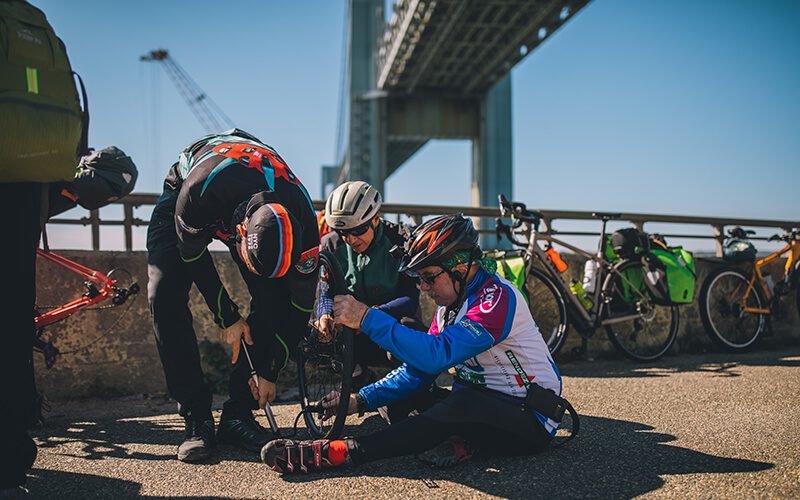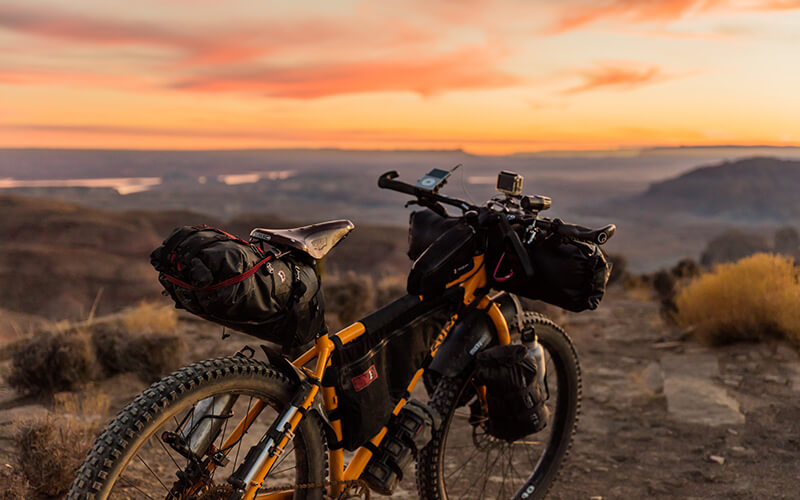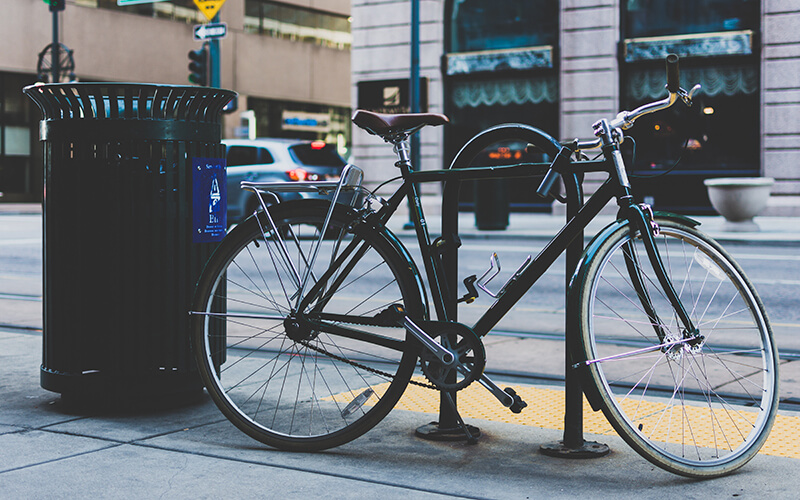New Bike 101: What to Know About Your New Ride

With Americans leery of taking public transit and in need of a way to stay active with gyms closed, many have turned to bicycles as a mode of transportation during the COVID-19 pandemic.
Google searches for “new bike” nearly doubled between May 2019 and May 2020, and bike shops and online retailers all over the world have reported shortages and order backlogs. Jeff Underwood, who runs CC Cyclery and Continuum Cycles in Manhattan, says interest among customers in buying a new bike is up about 200 percent, but the challenge has been the lack of availability of bikes to meet the demand.
If you’ve joined the throngs of new cyclists hitting the pavement, trails, and dirt roads across the country, here’s a checklist of what you need to know about your new ride and how to take care of it.
Must-Have Bike Accessories
When it comes to safety, the first item you’ll need is a helmet. You also need to wear it properly, and many cyclists don’t. A helmet should fit firmly on your head, with the front coming half-way down your forehead, and you should only be able to fit about two fingers between your chin and the chin strap. Wearing a helmet loosely or so far back that it doesn’t cover your forehead is like wearing a seatbelt with too much slack—it defeats the purpose.
Strong front and back lights are essential if you’re ever biking at dawn, dusk, or night. Not only will these lights make you visible to cars, they also help you see the road ahead, including any hazardous potholes or debris. Lights come in various shapes, sizes, styles, and strength. Some have USB ports to charge them, while others require batteries. Some lights can be mounted permanently directly onto the bike or helmet, while others are clipped or wrapped on and easily removed—if you choose a removable light set up, be sure to take them with you whenever you park your bike as lights can be easily stolen so always take them off when parked in public places.
You’ll also want to purchase a sturdy bike lock that can fit both your frame and front wheel. To get your back wheel, you can either use a separate lock or secure the back wheel with a cable lock. Front wheels are easier and quicker to remove so they tend to be more susceptible to theft, but if your back wheel is quick-release, it should always be locked.
Small upgrades, such as a new saddle (or seat), ergonomic handlebars (that provide a more comfortable position for your hands), and padded cycling gloves (which provide extra cushion for your hands and alleviate soreness) can have a dramatic impact on your ride. If any aspect of biking is uncomfortable, speak to your local shop about how to address it.
If you plan to ride in the winter (or even if you don’t plan to but wind up loving biking so much that you can’t stop), you’ll also want to invest in winter tires so you have more traction in the snow. If you ride in the rain, you’ll also want to invest in front and back fenders and a rainproof jacket or poncho. (I’m a fan of Cleverhood rain capes.)

Safety 101
A bike works best—and is the safest—when all its components operate properly. Brakes should be tight, wheels need to be secure, tires should be properly inflated, and chains must be greased. To achieve all this after you wheel your new bike out of the shop, you’ll want to have—at minimum—a bike pump, tire levers, a spare tube, a multi-tool, and chain lube at home. Each of these items, except for the lube, perhaps, should go with you wherever you pedal—in case of an emergency flat or repair.
Bike pump: You’ll need this to fill your tires with air. Your tubes will have one of two types of valves: Schrader (the same valve you see on car tires) or Presta (about half as wide as Schraders), so make sure the type of pump you have matches the type of valve in your tube. Better yet, get a bike pump that accommodates both valves. (most do these days)
Spare tube: As mentioned, the rubber tube inside the tire will feature either a Presta or Schrader valve. The numbers on the side of your tire refer to the outer diameter and width of the tire, which give you some guidance as to what size tube will fit. For instance, a tube that’s 26 x 1.4 has an outer diameter of 26 inches and a width of 1.4 inches. You want to make sure that your tire width fits within the range of your tube. Note that some tubes are displayed in inches, while others are displayed in centimeters, and many tubes give a range of bike tires they will fit. If any of this sounds confusing, double check with your bike shop.
Tire lever: This simple plastic tool is required to loosen the tire on your wheel so you can remove the tube to fix a flat.
Multi-tool: A hand-held tool that has various sized screwdriver and Allen wrench heads and can be used to tighten and loosen parts on the bike.
Chain lube: This lubricant keeps your bike chain (and your ride) smooth.
When your bike is functioning properly, your ride will be safer, more comfortable, and require less physical effort. If you’re not comfortable performing a tune-up on your own bike, head to your local bike shop. The amount of riding you do will determine how often you need to get a tune-up, but if you haven’t ridden the bike in a while, you should ask your shop if your bike needs one. In general, if you didn’t ride over the winter, a spring tune-up is a good idea.
While you’re there, inquire about a “bike fit” to make sure your bike is the right size for you. Riding a bike that is too small (or too big) or riding with the saddle too high/low or too close/far from the handlebars will make riding unnecessarily uncomfortable and can often be easily adjusted. According to Underwood, many people are riding the wrong sized bike and don’t even know it. He adds that “a lot of people that ride a bike that’s the right size for them are riding it with their saddle way too high or too low, which can cause knee, hip, and back pain. Riding your saddle too low also requires expending far more effort than necessary.”
Beginner-Friendly Routes
As cities begin re-opening and group activities resume across the country, look into any group rides in your area. Even if you’re not comfortable or interested in joining a group ride, you could get ideas for potential routes and destinations. Many AMC chapters have safely resumed group rides, and Meetup and Eventbrite are two more great places to search for bike-related groups and events. You could also search rides in your area on Strava or Ride With GPS, which display distance and elevation and give you an idea of the ride difficulty. For your first ride, start small with a few miles and relatively easy terrain, and work your way up from there depending on your comfort level and ability.
Keep in mind what your bike can handle. Road bikes with skinny tires aren’t equipped to ride on gravel or rugged mountain trails. Though you can ride mountain bikes on pavement, their thick, knobby tires and heavy frames make them best suited for trail riding. If you don’t know what style of bike you purchased, a bike shop mechanic can help you find out.

Storage Basics
Store your bicycle in a covered shed or hang it inside your home or apartment rather than leaving it outside in the elements. Not only will rain and snow rust and damage the bike, allowing your bike to fall into disrepair makes you less likely to use it in the future.
Heat can break down plastic and rubber parts on your bike, cold weather can cause your bolts to seize up, and moisture can cause your chain and components to rust. Weather-related degradation doesn’t always occur immediately so even if your bike has been fine outside thus far, you’ll eventually notice damage.
If you have a large house or garage with plenty of storage space, you’re all set. But if you live in a small apartment with minimal floor space, or you’re the owner of a bicycle that’s too heavy or bulky to haul up a few flights of stairs, you may need to put in a bit more effort to find a safe and secure solution. If space is a challenge, look into wall-mounted racks or freestanding floor racks. Some apartment buildings in urban areas have bike rooms inside the building or bike areas within the parking garage that are available to tenants, usually for an additional cost.
Cleaning Your Bike
Getting grime quickly off your bike (the chain, in particular) helps keep components in working order and prevents unnecessary friction while riding, meaning you expel less effort pedaling. Cleaning salt off your bike is even more important since it can eat away at the frame and components.
If you have a garage or driveway, set up a bike-cleaning station, complete with a hose, bucket, gloves, scrub brushes, and dish soap, which are great at cleaning off grease. If you live in an apartment with limited space, you’ll need to be more creative. Some riders will clean their bikes in a bathtub, or wipe down their bike with soap and water regularly. Bike shops also offer deep cleanings, which are great to do in the spring after the mud season.
Owning a bike is just like adopting a pet or buying a car—it requires ongoing attention and maintenance. Even if you didn’t consider the cleaning, storage, and ongoing care associated with owning a bike when you made the initial purchase, know that eventually, you’ll get the hang of it and professionals exist who are happy to help you along the way. Taking proper care of your bike means that it will always be there for you for exercise, transportation, and stress relief. Get to know your local bike shop, and happy riding.




